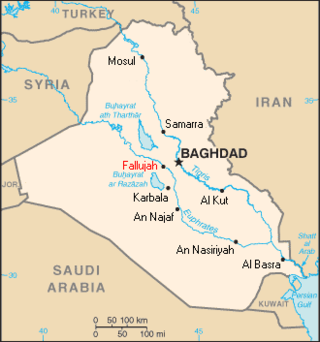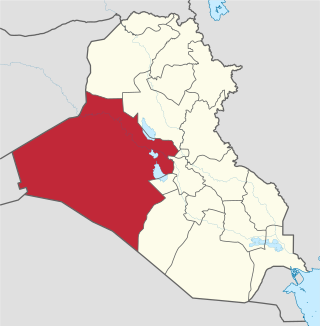
The Second Battle of Fallujah, initially codenamed Operation Phantom Fury, Operation al-Fajr was an American-led offensive of the Iraq War that lasted roughly six weeks, starting 7 November 2004. Marking the highest point of the conflict against the Iraqi insurgency, it was a joint military effort carried out by the United States, the Iraqi Interim Government, and the United Kingdom. Within the city of Fallujah, the coalition was led by the U.S. Marine Corps and U.S. Army, the battle was later described as "some of the heaviest urban combat Marines have been involved in since Huế City in Vietnam in 1968" and as the toughest battle the U.S. military has been in since the end of the Vietnam War. It was the single bloodiest and fiercest battle of the entire conflict, including for American troops.

The United States bombardment of Fallujah began in April 2003, one month after the beginning of the invasion of Iraq. In April 2003 United States forces fired on a group of demonstrators who were protesting against the US presence. US forces alleged they were fired at first, but Human Rights Watch, who visited the site of the protests, concluded that physical evidence did not corroborate US allegations and confirmed the residents' accusations that the US forces fired indiscriminately at the crowd with no provocation. 17 people were killed and 70 were wounded. In a later incident, US soldiers fired on protesters again; Fallujah's mayor, Taha Bedaiwi al-Alwani, said that two people were killed and 14 wounded. Iraqi insurgents were able to claim the city a year later, before they were ousted by a siege and two assaults by US forces. These events caused widespread destruction and a humanitarian crisis in the city and surrounding areas. As of 2004, the city was largely ruined, with 60% of buildings damaged or destroyed, and the population at 30%–50% of pre-war levels.

The 3rd Battalion 7th Marine Regiment (3/7) is an infantry battalion of the United States Marine Corps. They are based at the Marine Corps Air Ground Combat Center Twentynine Palms and consist of approximately 800 Marines. The battalion falls under the command of the 7th Marine Regiment and the 1st Marine Division. The battalion has seen combat in World War II, the Korean War, the Vietnam War, the Gulf War and was a part of the main effort during the initial invasion of Iraq in 2003. During the Global War on Terror, the battalion saw eleven sequential combat deployments; five in support of Operation Iraqi Freedom, three in support of Operation Enduring Freedom, and three in support Operation Inherent Resolve. The unit has a long, decorated history with countless achievements. Its members were described as "true professionals" by embedded reporters during the 2003 invasion of Iraq.

1st Battalion, 24th Marines (1/24) is a reserve infantry battalion in the United States Marine Corps located throughout Michigan, Ohio, and Indiana consisting of approximately 1,000 Marines and Sailors. Nicknamed Terror from the North, the battalion is attached to the 25th Marine Regiment of the 4th Marine Division.

The Battle of Ramadi was fought in the spring of 2004, during the same time as the First Battle of Fallujah, for control of the capital of the Al Anbar Governorate in western Iraq. A coalition military force consisting of the 2nd Battalion, 4th Marines were stationed to defend the city from an insurgent assault.

The Battle of Ramadi was fought during the Iraq War from March 2006 to November 2006, for control of the capital of the Al Anbar Governorate in western Iraq. A joint US military force under the command 1st Brigade Combat Team, 1st Armored Division and Iraqi Security Forces fought insurgents for control of key locations in Ramadi. Coalition strategy relied on establishing a number of patrol bases called Combat Operation Posts throughout the city.
Anbar Salvation Council is a collection of tribal militias in the Al Anbar province of Iraq, formed by former Ba'athists and nationalists to fight al-Qaeda in Iraq and other associated terrorist groups. In Arabic the council is known as Sahawa Al Anbar, abbreviated SAA when referred to by the US Army. The council has become a model for awakening movements across Iraq, though the Iraqi Defense Ministry has said that it plans to disband the Awakening groups due to concerns about their origins and future intent.
Al-Karmah, also sometimes transliterated as Karma, Karmah, or Garma, is a city in central Iraq, 16 km (10 mi) northeast of Fallujah in the province of Al Anbar.

Operation Phantom Thunder began on 16 June 2007, when Multi-National Force-Iraq launched major offensive operations against al-Qaeda and other extremist terrorists operating throughout Iraq. It was the largest coordinated military operation since the 2003 invasion of Iraq. Operation Phantom Thunder was a corps level operation, including Operation Arrowhead Ripper in Diyala Province, Operation Marne Torch and Operation Commando Eagle in Babil Province, Operation Fardh al-Qanoon in Baghdad, Operation Alljah in Anbar Province, and continuing special forces actions against the Mahdi Army in southern Iraq and against Al-Qaeda leadership throughout the country. The operation was one of the biggest military operations in Iraq since the U.S. invasion in 2003.

Operation Alljah was an operation launched by Coalition forces in Iraq, mainly U.S. Marines, in June 2007 to secure the neighborhoods of Fallujah. The strategy of the operation was somewhat based on a successful operation in Ramadi conducted in 2006. Insurgents in the town of Karma nearby were also targeted during the operation, which was part of the overall operation Phantom Thunder.

Tanzim Qaidat al-Jihad fi Bilad al-Rafidayn, more commonly known as Al-Qaeda in Iraq, was a Salafi jihadist organization affiliated with Al-Qaeda. It was founded on 17 October 2004, and was led by Abu Musab al-Zarqawi and Abu Ayyub al-Masri until its disbandment on 15 October 2006.
The Battle of Donkey Island was a skirmish that occurred on 30 June and 1 July 2007 between elements of the U.S. Army Task Force 1-77 Armor Regiment, the 2nd Battalion 5th Marines and a numerically superior force of al-Qaeda in Iraq insurgents on the banks of a canal leading from Ramadi to Lake Habbaniyah in the Al-Anbar province of Iraq.
The 2008 al-Qaeda offensive in Iraq was a month-long offensive conducted by al-Qaeda in Iraq against the multinational coalition of USA, UK, Australia and Poland.

The Anbar campaign consisted of fighting between the United States military, together with Iraqi security forces, and Sunni insurgents in the western Iraqi governorate of Al Anbar. The Iraq War lasted from 2003 to 2011, but the majority of the fighting and counterinsurgency campaign in Anbar took place between April 2004 and September 2007. Although the fighting initially featured heavy urban warfare primarily between insurgents and U.S. Marines, insurgents in later years focused on ambushing the American and Iraqi security forces with improvised explosive devices (IEDs), large scale attacks on combat outposts, and car bombings. Almost 9,000 Iraqis and 1,335 Americans were killed in the campaign, many in the Euphrates River Valley and the Sunni Triangle around the cities of Fallujah and Ramadi.
Operation Murfreesboro was one of the closing engagements of the Battle of Ramadi during the Iraq War and resulted in a decisive victory for the United States Forces over the Islamic State of Iraq. It is widely credited with breaking the back of the insurgency in Anbar Province, resulting in the Anbar province favoring the new Iraqi government in Baghdad.
In 2009, following the withdrawal of US forces from Iraqi cities on 30 June, a campaign of car bomb attacks was conducted throughout Anbar Governorate. In early 2009, U.S. forces began pulling out of cities across the country, turning over the task of maintaining security to the Iraqi Army, police, and their paramilitary allies. Experts and many Iraqis worried that in the absence of U.S. soldiers, AQI might resurface and attempt mass-casualty attacks to destabilize the country. There was indeed a spike in the number of suicide attacks, and through mid and late 2009, al-Qaeda in Iraq rebounded in strength and appeared to be launching a concerted effort to cripple the Iraqi government.

Operation Sayeed also known as Operation Hunter in English, was a series of operations conducted in western Al Anbar Governorate by the United States Marine Corps in 2005. It was an umbrella operation, consisting of at least 11 named operations between July 2005 to December 2005. The purpose was to drive Al-Qaeda in Iraq forces from the Western Euphrates River Valley. Some parts of Operation Sayeed were Operation Steel Curtain and Operation Iron Fist.

Ramadi, the capital of Iraq's Al Anbar Governorate, was under U.S. military occupation during the Iraq War. It was a focal point of Iraqi insurgency, which erupted into open armed conflict in 2004 and in 2006, part of the Iraq War in Anbar Province. Operation Murfreesboro was a U.S. offensive in February 2007 intended to cut off the Ma'Laab district of eastern Ramadi from the rest of the town in order to drive out Zarqawi's Al-Qaeda in Iraq.

Beginning in December 2012, Sunnis in Iraq protested against the Maliki government. On 28 December 2013, a Sunni MP named Ahmed al-Alwani was arrested in a raid on his home in Ramadi. Alwani was a prominent supporter of the anti-government protests. This incident led to violence in Al Anbar Governorate between the Iraqi Army and a loose alliance of tribal militias and other groups fighting alongside the Islamic State of Iraq and the Levant (ISIL).

The Al-Karmah offensive, codenamed Fajr al-Karma, was an offensive launched by the Iraqi Army and anti-ISIL Sunni tribal fighters to recapture the Al-Karmah district taken by the Islamic State of Iraq and the Levant in Iraq. The offensive began on 14 April 2015. During the offensive the anti-ISIL forces captured part of the city of Al-Karmah, and the old road of Al-Karmah.












